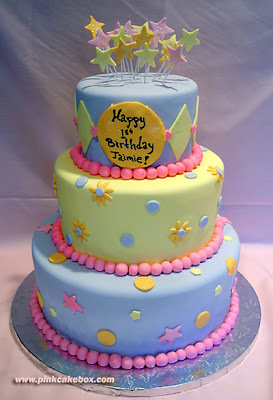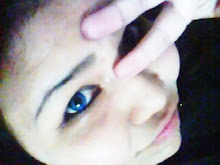
Tuesday, April 28, 2009
Saturday, April 25, 2009
Friday, April 24, 2009
Assignment Three*Part 4- The Mask
Thursday, April 23, 2009
Assignment Three* Part 3.2- Cake finnished*
Assignment Three* Part 3.1- Cake*
Thursday, April 16, 2009
Assignment Three: Part 2 *My references*
Assignment Three: Part 1.1 *My research*
From Wikipedia, the free encyclopedia
Birthday is the name given to the date of the anniversary of the day of a person's birth. People in many cultures celebrate this anniversary. In some languages, the word for birthday literally translates as "anniversary". Birthdays are traditionally marked by celebrations including a birthday party or, in some particular cases, a rite of transition.Opposition
The celebration of birthdays is not universal. Orthodox Christianity prefers the celebration of name days. Some Christian communities may celebrate both naming days and birthdays.
The Jewish perspective on birthday celebrations is disputed by various rabbis.[1] In the Hebrew Bible, the one single mention of a celebration being held in commemoration of someone's day of birth is for the Pharaoh.[2] The bar mitzvah of 13-year-old Jewish boys, or bat mitzvah for 12-year-old girls, is perhaps the only Jewish celebration undertaken in conjunction with a birthday; however, the essence of the celebration is entirely religious in origin (the attainment of religious maturity according to Jewish law) not secular, despite modern celebrations where the secular "birthday" elements predominate. With or without the "birthday" celebration, the child still automatically attains his or her bar or bat mitzvah, and its celebration may be any date following his or her 13th anniversary of birth.
Some Sunni and Shia Muslim scholars oppose birthdays[citation needed], but some allow celebration of the birthday of the prophet Muhammad, although it is important to note there is no basis for this practice (i.e., no evidence in the Quran or Authentic Hadith).
Celebration
Main article: Birthday cake
The birthday cake is traditionally highly decorated, and typically covered with lit candles when presented, the number of candles signifying the age of the celebrant. The person whose birthday it is may make a silent wish and then blow out the candles. After that, the person can open their presents. It is also common for the person celebrating their birthday to cut the initial piece of the cake as a newlywed couple might with a wedding cake.
Sometimes special candles are substituted for the many individual candles in the shape of a numeral. For example, on the fifth birthday, there may be one candle on the cake in the shape of the numeral five, and on the fiftieth birthday there may be two candles on the cake, one in the shape of the numeral five followed by the other in the shape of the number zero.Traditions
In addition to parties, it is common for people to receive gifts on their birthdays or surprise parties. However, sometimes it is expected of the person celebrating their birthday to treat their party guests instead; this varies depending on the local culture and may involve party gifts or other gestures
Assignment Three: Part one *Birthday Card*
Birthday Celebrations from Malaysia
In Malaysia all birthday celebrations family members and friends gather together to enjoy food. They may sing along together or play musical instruments. Friends or relatives who visit give presents to the person celebrating their birthday or they may give an ang-bao. This is a small red packet filled with money. If relatives do not know what to buy, the money is a good present.
At about 16 when teenagers start to invite boys and girls to their parties there is lots of dancing and games to help find a partner. They often make up their own games so that everyone eventually finds their own partner. The trick is always to have the same numbers of boys and girls! At 18 birthdays are celebrated with family members or people may go to the movies with their boy/girlfriend. At 21 people usually have a big party.
At all birthday celebrations people have birthday cake with candles and they sing the Happy Birthday song in English, Chinese or Malay.
The story Begins:
I was brought up in Malay
traditions, and my parents said it's not Malay culture to blow candles,we just
have to pray to God. But still sing Happy birthday to me and usually, my mom
bought a cake every year to celebrate my birthday. Cake was serve but with-out
blowing the candle. I love cake so much...especially Chocolate moist Cake.
Yummy!!lol
Monday, April 6, 2009
Celebrating
Usually on the eve of the celebrations, family members, especially mothers and housewives, will be busy preparing food, cakes, sweets, biscuits and various delicacies to be served on the day of Hari Raya. Delicacies such as ketupat or rice cake and a meat cuisine called rendang are among the most famous cuisines that are served during this day. Other family members will help in other chores such as decorating and cleaning up the house.
Days before Hari Raya, house compounds, particularly those in the countryside will be lit up with oil lamps known as pelita or panjut. This display of oil lamps will reach its height on the 27th night of Ramadan, called the Tujuh Likur night. 'Likur' literally meaning a figure between 20 and 30, hence 'tujuh likur' means twenty seven. Originally during the early days of the arrival of Islam among the Malays, the purpose of lighting the oil lamps was to attract spirit of passed relatives and angels to descend to people's homes during the night of Lailatulqadar. However after ages has passed, such misconception is regarded counterfactual as much understanding of Islam were obtained. Nowadays the oil lamps are lit solely for decorative purposes.
It is customary for Malays to wear traditional Malay costumes. The dress for men is called baju Melayu while the women's are known as baju kurung and baju kebaya. Traditional textiles such as songket and batik are worn favourably during this day.
Muslims will attend Eid prayer in the morning and consecrate together harmoniously while taking the chance to meet and greet each other. Once the prayer is done, it is also common for Muslims in Malaysia to visit the grave of their loved ones. During this visit, they will clean the grave, perform the recital of the Yasin — a chapter (surah) from the Qur'an and also the tahlil or prayers for the deceased. All these are done in hope that their loved ones are blessed by God and they are spared from the punishment in the grave.
The rest of the day is spent visiting relatives or serving visitors. Hari Raya is a very joyous day for children for this is the day where adults are extra generous. Children will be given token sums of money, also known as duit raya from their parents and elders.
During the night, there are often celebrations with sparklers and firecrackers, albeit restrictions on playing firecrackers enforced by the authorities. Most firecracker stocks are purchased and smuggled illegally from black markets. Safety issues, especially among children are raised and alarming cases relating to injuries caused by playing firecrackers are often reported, which initially led to the banning of playing firecrackers. Despite of the enforcement of banning firecrackers, more Malay children turn to home-made firecrackers such as meriam buluh (bamboo cannon) as alternatives to commercial fireworks. Usually the lighting of firecrackers begins a few days before the end of Ramadan, and continues for about a week afterwards.














